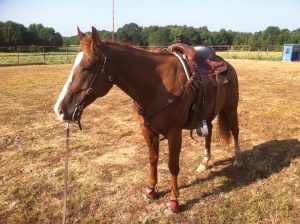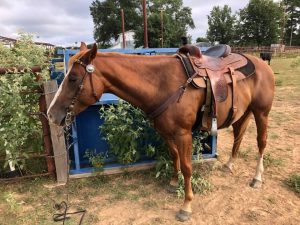 The last few months, Knockout (my 7-yo AQHA quarter horse gelding) and I have been spending a lot of time checking cows and checking fence. Most weekday evenings we do a quick check before dark. Most weekend mornings we do a more relaxed and thorough check, spending a little more time getting acquainted with each cow.
The last few months, Knockout (my 7-yo AQHA quarter horse gelding) and I have been spending a lot of time checking cows and checking fence. Most weekday evenings we do a quick check before dark. Most weekend mornings we do a more relaxed and thorough check, spending a little more time getting acquainted with each cow.
It would sound a lot cooler if I said we’ve been working cows…but that might be a bit misleading. We’re not out there roping, branding, or doctoring cows. In general, we’re not even moving cows…though we have started playing with gathering and pushing a little bit just to get a feel for it. We even pushed a few calves back into the pasture after they got out, the other day. Most of the time, we just ride around making sure all the cows look healthy and sound, read ear tag numbers to check off my list, and count the calves to make sure everyone is accounted for. Then we ride the fence to make sure it’s in good repair…and ride by the electric fence chargers to make sure they’re clicking and flashing like they’re supposed to be.
It’s pretty simple stuff. I suspect this is the sort of stuff that once made up the lifestyle of a historical cow-boy. Before the dangerous Texas cattle drives through Indian Territory added the sense of adventure, and before the dime novels romanticized the western cowboy lifestyle, a cow-boy was simply a boy who took care of the cows…much like a shepherd takes care of sheep.
That’s what Knockout and I have been doing the last few months. We check cows.
I’ve been amazed at how checking cows has changed the dynamic of our rides. We used to ride the same pastures and woods trails we’re riding now. Previously, though, the focus was on us and our teamwork.
Sure, I enjoyed the beauty of nature as we went, and we would sometimes stop to watch the calves play. However, my main focus was on Knockout. Was Knockout responding promptly to my cues? Was Knockout keeping his attention on me? Was Knockout responsive to my body language? Was Knockout tense or was he relaxed as we rode? Was Knockout compliant or resistant? Was Knockout traveling in straight lines at constant rates of speed?
Then there was also a lot of focus on myself. Were my hands light on the reins? Did I have plenty of slack in the reins? Was I practicing good rein management? Were my cues light? Was my timing good? Was I carrying an independent seat? Was I dropping all pressure when headed in the desired direction? Was my body positioned facing the direction I wanted to go and eyes focused on a distant goal point?
Similarly, Knockout’s main focus was on me and my cues…except when he was focused on where he wanted to go…like back home. Or when he was focused on what he could startle at…like my helmet brushing a branch as we rode under it. When these things happened, my focus became making sure Knockout’s focus returned to me.
Now, none of these are bad things. For the stage we were at, they were necessary areas of focus. Furthermore, they have never stopped being necessary. I still pay attention to these things…but now they’re more in the background…not subconscious but not at the forefront of my focus, either.
Now my primary focus is on the cows and fencing. Where is the herd? Is the herd together or scattered? What is my best approach to make sure I check each cow? What is my best route thru the herd as I check ear tags? Which ear tags can I check off from a distance just by knowing the markings of individual cows? What is my best approach to each cow, to get a good look at her ear tag without spooking her into turning away from me or walking off? Are any cows hidden behind that wall of brush near the back fence line? Are any cows lying down in the shade of the woods? Why am I coming up one cow short in my count? Where is the missing cow hidden…or did I just overlook her as I rode through the herd?
Likewise while checking fence, I’m focused on seeing a thin wire. Is it tight or sagging? If it is sagging, where’s the break? Is the wire on each post insulator? If not, I need to dismount to put the wire back in place at each fence post. Is anything shorting the fence out? Does that fallen branch need to be moved? Why isn’t the electric fence charger ticking? Is the battery connection loose? When did we last charge the battery?
Now, behind all that, I’m still riding. I’m still doing rein management and hopefully using appropriate pressure with good timing. But that is no longer in the forefront of my thoughts.
And you know what? As my focus has changed, Knockout’s focus has begun to change, too. He’s no longer looking for a chance to go back home. We’re riding through rougher terrain with more high brush and low branches than we ever did before, yet Knockout rarely startles at anything. Like myself, Knockout is focused on the cows. As I leave one cow and turn to head toward another, Knockout is already looking to see which cow we’re approaching next. As we approach a cow, Knockout is eagerly waiting to see if we’re going to direct the cow somewhere or just read an ear tag and ride on.
Knockout loves directing cows! We’re not very good at it, yet, but he sure loves doing it.
As we work together, Knockout and I are both learning to plan approach angles and speed. We’re learning to adjust our speed to intercept a moving cow without spooking her. When pushing a cow, we’re learning to be aware of speed, flight zone, and balance point. We’re learning to trust each other to do our jobs even as we learn together and fill in for each other.
While checking fence, Knockout has begun to keep one eye on the wire just as I am. He knows to stay near the fence line without getting too close. He is beginning to learn when something is wrong with the fence wire we are going to stop for me to dismount and correct the issue. And he has learned to stand patiently ground-tied while I fix the fence.
I’ve also noticed I have less tendency to micromanage than before. When we’re tracking a cow, I’m likely to just let Knockout go, confident he knows what to do. When we’re checking fence, if I can see Knockout is paying attention to tracking beside the fence, I’m likely to just let him go, confident he knows to follow the wire. When fixing fence, I just drop the reins on the ground and go about my business, trusting Knockout to stay put until I come back. When crossing a creek, I’m likely to let him move over a couple of steps if he chooses…after all he’s the one who has to maintain his footing as we cross.
Tending cows is becoming a common goal we both work on together. Rather than focusing on our teamwork, we are beginning to work together as a team for a common purpose. Rather than practicing transitions, we frequently transition speed and gait as part of the job. Rather than practicing turns and laterals, we turn and move as needed to get the job done.
It’s sort of like the difference between a football practice and a football game. Yes, the practice is important and necessary, but the game is where the team really comes together toward a common goal.
Working together on necessary tasks has given our rides a sense of purpose. Knockout and I have both embraced that purpose, resulting in a closer sense of partnership. We don’t work against each other as much, because we’re busy working together toward a common goal.
Isn’t that what God does with us?
When Jesus discipled the twelve apostles, they didn’t just sit around soaking up Jesus’ teaching and enjoying the fellowship. Jesus sent them out to minister to others. He gave them very explicit instructions on how they were to conduct themselves, and told them:
“And as you go, preach, saying, ‘The kingdom of heaven is at hand.’ Heal the sick, raise the dead, cleanse the lepers, cast out demons. Freely you received, freely give.” (Matthew 10:7-8)
Jesus didn’t just minister to the disciples. Rather He asked them to join Him in ministry. He entrusted them with an important job. Jesus gave clear and explicit directions without micromanaging. He called the apostles to a mission with purpose.
Jesus calls us to the same purposeful mission:
And Jesus came up and spoke to them, saying, “All authority has been given to Me in heaven and on earth. Go therefore and make disciples of all the nations, baptizing them in the name of the Father and the Son and the Holy Spirit, teaching them to observe all that I commanded you; and lo, I am with you always, even to the end of the age.” (Matthew 28:18-20)
Notice we are not alone in this mission. Jesus is with us. We’re working together toward a common goal.
At His last supper with the disciples, Jesus gave them further instructions:
“A new commandment I give to you, that you love one another, even as I have loved you, that you also love one another. By this all men will know that you are My disciples, if you have love for one another.” (John 13:34-35)
This is our mission, our purposeful common goal. Go make disciples and love one another.
This is how Christ draws us into closer relationship with Him…by inviting us to join Him in working toward these common goals.
Are you working with Christ to accomplish these necessary tasks?

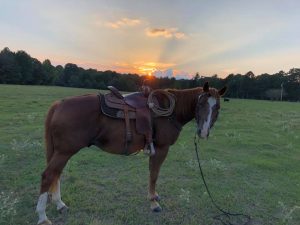 Horses are social creatures. They like being around other horses. In many ways, they are very dependent on other horses.
Horses are social creatures. They like being around other horses. In many ways, they are very dependent on other horses.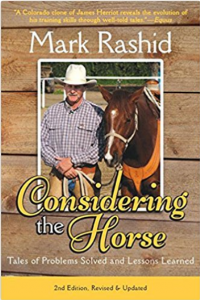 I just finished reading another of Mark Rashid’s books, titled “
I just finished reading another of Mark Rashid’s books, titled “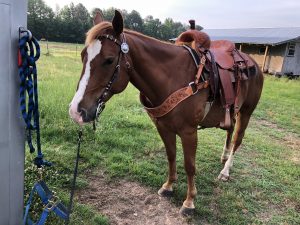 Saturday morning, Knockout and I started out on a relaxing pasture ride.
Saturday morning, Knockout and I started out on a relaxing pasture ride.
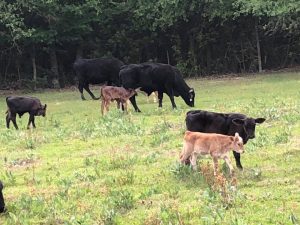 As we headed out of the arena toward the back pasture, Knockout walked toward the path we usually take. However, the cattle herd was on the east side of the pasture and I wanted to check on the young calves. So, I gently asked Knockout to head that direction. He promptly turned where I asked…then just as promptly started swinging back toward the familiar route. So, I repeated the soft cue. Again he promptly responded then started swinging back to familiar paths.
As we headed out of the arena toward the back pasture, Knockout walked toward the path we usually take. However, the cattle herd was on the east side of the pasture and I wanted to check on the young calves. So, I gently asked Knockout to head that direction. He promptly turned where I asked…then just as promptly started swinging back toward the familiar route. So, I repeated the soft cue. Again he promptly responded then started swinging back to familiar paths.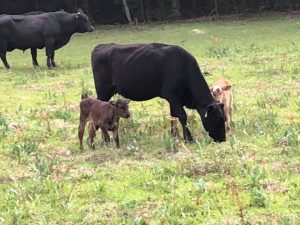 The young calves and the mama cows all looked healthy. I pulled out my cell phone and snapped a few pictures before we continued on. As we left the herd, Knockout again picked up into a nice smooth trot which we continued all the way around the back of the pasture until I slowed him to a walk as we entered the woods.
The young calves and the mama cows all looked healthy. I pulled out my cell phone and snapped a few pictures before we continued on. As we left the herd, Knockout again picked up into a nice smooth trot which we continued all the way around the back of the pasture until I slowed him to a walk as we entered the woods.